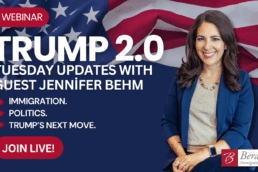U.S. Citizenship and Immigration Services (USCIS) requires an employer who seeks to sponsor a temporary worker in an H-1B specialty occupation is required to establish a valid “employer-employee relationship.” In 2020, the agency issued an updated policy guidance to adjudication officers, which clarified the requirements to establish an “employer-employee relationship” to qualify for the H-1B specialty occupation classification, including third-party site placements.
Establishing an Employer-Employee Relationship
Under the Code of Federal Regulation (CFR), a “United States employer” is defined as a person, firm, corporation, contractor, or other association or organization in the United States which:
- Engages a person to work within the United States;
- Has an employer-employee relationship with respect to employees under this part, as indicated by the fact that it may hire, pay, fire, supervise, or otherwise control the work of any such employee; and
- Has an Internal Revenue Service Tax identification number.
The USCIS policy guidance provides that an adjudicating officer should apply the existing regulatory definition in assessing whether an employer and a beneficiary have an employer-employee relationship. This means that an adjudicating officer should consider whether the petitioner has established that it meets at least one of the “hire, pay, fire, supervise, or otherwise control the work of” factors with respect to the beneficiary. More specifically, an adjudicating officer should consider the manner and extent to which the petitioner actually supervises the beneficiary; the petitioner’s right to control the beneficiary’s daily work and work product; and the petitioner’s right to hire, pay and fire the beneficiary.
H-1B petitioners are required to submit a Labor Condition Application (LCA) and a copy of any written contracts between the petitioner and the beneficiary, or a summary of the terms of the oral agreement if a written contract does not exist. This is to prove that a bona fide job offer exists at the time of filing. Depending upon the content of such documentation, it may establish the employer-employee relationship.
With respect to third-party placements, an H-1B petitioner is not required by existing regulation to submit contracts or legal agreements between the petitioner and third parties. However, the petitioner must demonstrate eligibility for the benefit sought. In assessing whether an employer and a beneficiary have or will have an employer-employee relationship, the officer may consider any evidence provided by the petitioner, including chain of contracts or legal agreements between the petitioner and third parties. Further, if a petitioner provides contracts or legal agreements, the officer is not precluded from evaluating that evidence in the adjudication of other eligibility criteria.
Conclusion
Through its 2020 policy guidance, USCIS has provided clarity on the criteria that establishes a valid “employer-employee relationship.” The policy guidance provides that adjudicating officers should consider the “hiring, paying, firing, supervising, or otherwise controlling the work of the employee” factors. It also emphasizes that adjudicating officers must review these factors in the totality of circumstances when making a final determination of whether the “employer-employee relationship” exists.
If you have any questions about the H-1B specialty occupation classification, contact our office today to set up a consultation with one of our attorneys!
Related Posts
December 10, 2025
Webinar: “Trump 2.0: Tuesday Updates With Guest Jennifer Behm”
December 10, 2025
Success Story: Event Management and Marketing Firm’s E-2 Visa
Ready to have Berardi on your side?
Whether you’re a business looking to hire or a professional hoping to relocate, immigration law can be complicated. But you don’t have to do it alone. Put our experience to work for you.



